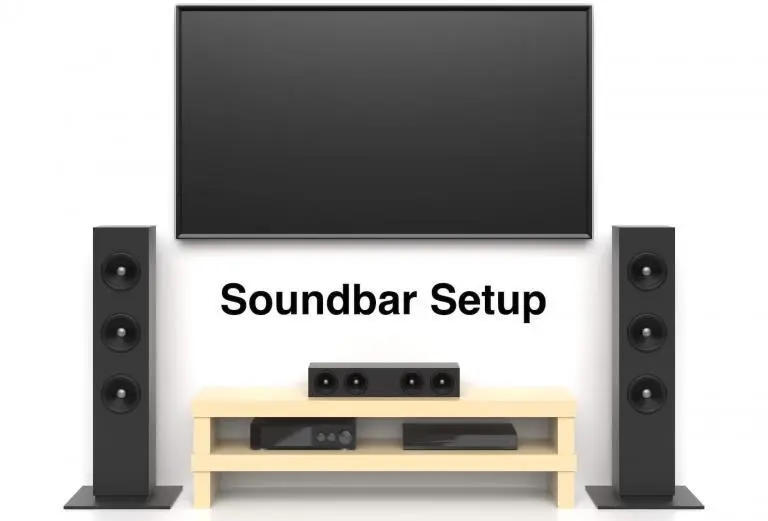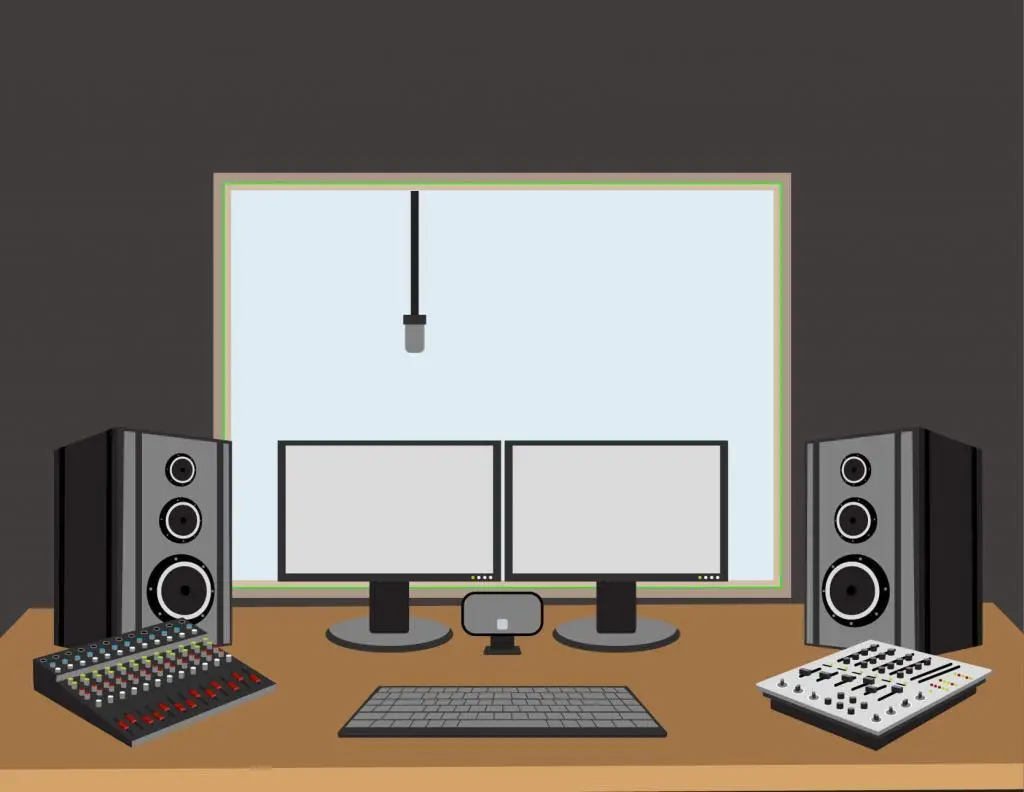
Soundbar setup can transform your home theater experience from “just okay” to “absolutely amazing.” This guide offers a streamlined approach to choosing, installing, and optimizing a soundbar for cinematic audio right in your living room. Whether you’re a tech novice or a seasoned audiophile, we’ll help you elevate your audio game to the next level.
Before you embark on your soundbar setup journey, you’ll need the following:
For a successful soundbar setup, you’ll need a compatible high-definition TV, the soundbar itself, appropriate cables for connection, a remote control for ease of use, and WiFi or Bluetooth for wireless features.

Physical placement is a pivotal aspect of your soundbar setup. It sets the stage for the audio quality and overall effectiveness of your home theater system. Whether you choose to position your soundbar below your TV on a stand or mount it on the wall, the goal is to place it where it will project sound most efficiently. Proper placement ensures that audio is distributed evenly throughout the room, enhancing your viewing and listening experience.
Selecting the right connection method is crucial for an effective soundbar setup. The type of connection can influence both audio quality and functionality. Here are some common methods:
This method provides superior audio quality and allows for easier control through a single remote. It enables your TV and soundbar to communicate more effectively, which is particularly useful for features like volume control.
An optical cable connection is a good fallback option if HDMI-ARC isn’t available. It offers good sound quality but lacks some of the advanced features you get with an HDMI connection, like CEC (Consumer Electronics Control).
These older connection methods are generally less recommended but can still be useful, especially for setups involving older technology. Audio quality will generally be acceptable but not outstanding.
Bluetooth and WiFi connections offer a wire-free experience, which is aesthetically pleasing and minimizes clutter. However, wireless methods might slightly compromise on audio quality compared to a wired connection.
By understanding your options and the impact they have on your soundbar setup, you can make an informed decision that best suits your specific needs and maximizes your audio experience.

Incorporating additional features can elevate your soundbar setup from basic to extraordinary. These enhancements add depth, immersion, and modern conveniences to your audio experience. Here are some key additional features you might consider:
A subwoofer is excellent for adding bass and depth to your soundbar setup. Some soundbars come with a built-in subwoofer, while others require an external unit. Either way, a subwoofer enhances low-frequency sounds, making explosions in movies feel more impactful and bass in music more resonant.
To achieve an authentic surround sound experience, adding rear speakers to your soundbar setup is beneficial. This allows sound effects to come from behind you, providing a 360-degree sound field that’s particularly effective for movies and live sports.
Modern soundbars often feature built-in voice control capabilities, like Alexa or Google Assistant. This adds a layer of convenience to your soundbar setup, allowing you to adjust volume, change inputs, or even control smart home devices with simple voice commands.
Many modern soundbars come with built-in streaming services like Spotify, Apple Music, or Pandora. This saves you from needing an additional device and makes it easier to play your favorite music or podcasts, right from your soundbar setup.
Some soundbars offer customizable EQ (equalizer) settings, letting you adjust bass, midrange, and treble to suit your taste. You can usually access these settings through a dedicated app or directly on the soundbar, allowing for a personalized audio experience in your soundbar setup.
By integrating one or more of these additional features, you can create a soundbar setup that not only improves audio quality but also enhances usability and immersion.
After you’ve positioned your soundbar and any additional components like a subwoofer or rear speakers, the final step in perfecting your soundbar setup is calibration and adjusting sound settings. This ensures that you’re extracting the best possible performance from your equipment. Here are some tips on how to finalize your setup:
Some advanced soundbars come with automatic calibration features. These utilize built-in microphones to analyze room acoustics and automatically adjust various sound parameters. If your soundbar offers this, it’s a quick way to optimize your soundbar setup without manual tinkering.

If you prefer hands-on adjustments or your soundbar doesn’t offer automatic calibration, you can manually set your system’s audio parameters. This usually involves adjusting the bass, treble, and possibly the balance of speakers in a surround sound setup. Some soundbars also offer advanced settings like dialogue enhancement and night modes in their soundbar setup options.
Most soundbars come with pre-configured sound modes such as Movie, Music, and Sports. These modes adjust your soundbar’s settings to suit the type of content you’re watching or listening to. For a tailored audio experience, try out these modes to see which works best for you.
Lastly, make sure your soundbar’s firmware is up-to-date. Manufacturers regularly release updates to fix bugs or improve performance. This ensures that your soundbar setup remains optimized over time. Check the manufacturer’s website or use the soundbar’s app for easy updating.
By calibrating and fine-tuning your soundbar’s settings, you can complete your soundbar setup with confidence, knowing you’re enjoying the best audio quality your system can provide.

Maintaining your soundbar setup is just as important as the initial setup. Regular upkeep ensures that your system remains at peak performance, provides the best sound quality, and keeps up with technological advancements. Here are some pointers for ongoing maintenance and updates:
Dust and grime can accumulate on your soundbar and other components like subwoofers or rear speakers. This not only affects aesthetics but can also interfere with the sound quality. Use a microfiber cloth to gently wipe down the surface of your soundbar and associated equipment.
Manufacturers frequently release software updates that can improve functionality or resolve issues. Make it a habit to check for firmware updates for your soundbar setup. This can often be done through the soundbar’s user interface or a dedicated app.
Wired connections can loosen over time or suffer from wear and tear. Periodically, check all cables in your soundbar setup to ensure they are snug and in good condition. Replace any worn-out cables as needed.
Your room’s acoustics can change if you rearrange furniture or add new elements like rugs or curtains. If you notice a change in audio quality, consider re-calibrating your soundbar setup. Some systems offer a quick calibration process that can be done via the remote control or a dedicated app.
If your soundbar or its remote control uses batteries, be sure to replace them as needed. Some modern remotes give a warning when the battery level is low, making this easier to manage.
Every so often, run a full functionality test on your soundbar setup to make sure everything is working as it should. This includes checking all sound modes, turning on and off any voice assistants, and ensuring that any wireless components like Bluetooth or Wi-Fi are functioning correctly.
Technology is ever-evolving, and new features may become available that can enhance your soundbar setup. Stay informed about new models or updates to see if any would benefit your setup.
By actively maintaining your soundbar setup, you’ll ensure that your system stays in excellent condition, offering high-quality sound for a longer period.
In summary, optimizing your soundbar setup involves careful selection of hardware, thoughtful physical placement, the right connection methods, and fine-tuning additional features and sound settings. From the basic requirements like a high-definition TV and proper cables to advanced features like subwoofers and smart assistants, each element plays a crucial role in your overall audio experience. Regular maintenance and updates are also key to ensuring long-lasting performance. By paying attention to each of these aspects, you can maximize both the sound quality and enjoyment of your home theater system.
Disclaimer:
The content provided on SoundBarsReview.com is intended solely for informational use. We do not guarantee the accuracy, reliability, or suitability of the information presented. Utilizing the information is at your own discretion and risk. We may earn a small commission through Amazon Associate links for qualifying purchases. All product names, images, and trademarks are the property of their respective owners.
© SoundBarsReview.com 2023 | Disclosure